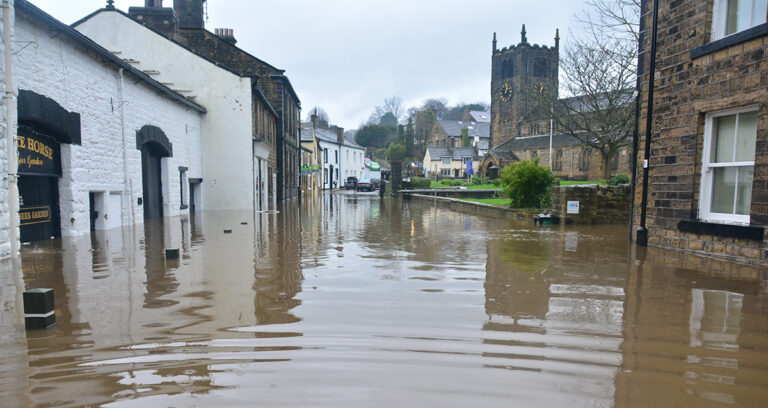Financing climate change adaptation in the UK and beyond


By Emma Howard Boyd, Chair of the Environment Agency in England and interim Chair of the Green Finance Institute
The IPCC recently stated that “Climate change impacts and risks are becoming increasingly complex and more difficult to manage.” Yet, adapting to these risks and improving how we manage them is crucial. Part of this lies in financing. In this post for the Sustainable Finance Leadership series, Emma Howard Boyd describes challenges and progress in financing climate resilience in the UK and the wider world.
The latest report from the Intergovernmental Panel on Climate Change, Climate Change 2022: Impacts, Adaptation and Vulnerability, said: “The world faces unavoidable multiple climate hazards over the next two decades with global warming of 1.5°C. Even temporarily exceeding this warming level will result in additional severe impacts, some of which will be irreversible.” Agreed by 195 governments, the Summary for Policy Makers is startling and urgent. The IPCC says that people’s health, lives and livelihoods, as well as property and critical infrastructure, including energy and transportation systems, are being increasingly adversely affected by hazards from heatwaves to storms, droughts and flooding, as well as by slow-onset changes, including sea level rise. It says beyond 2°C climate-resilient development will be an impossibility for some regions.
The IPCC is clear, too, that while some progress is being made on financing adaptation and resilience to these impacts, this financing remains woefully insufficient, yet “Climate resilient development is enabled by increased international cooperation including mobilising and enhancing access to finance, particularly for vulnerable regions, sectors and groups.”
The IPCC report references the Coalition for Climate Resilient Investment (of which I am one of the co-Chairs). The CCRI is looking at how investors can systematically incorporate physical climate risks, adaptation and resilience into cash flow modelling and asset valuation practices. This will help investors to quantify investments in the resilience of assets, and the benefits associated with reduced costs and more reliable revenue streams.
Mobilising finance for adaptation in the UK
The IPCC points to a global problem experienced by local communities. In the UK last year, more than 76,000 incidents were reported to the Environment Agency’s incident management service, including flooding, drought, fires, fish kills and pollution incidents. The Environment Agency’s Long Term Investment Scenarios show that for every property that is flooded, 16 other people are affected by disruption to infrastructure and services. Climate change is increasing the severity, frequency and duration of such incidents.
Yet it appears that worryingly few investors are considering the physical risks climate change. For example, the UK’s 2021 National Infrastructure and Construction pipeline sets out plans for nearly £650 billion of public and private infrastructure investment by 2030. The Infrastructure and Projects Authority has analysed over £200 billion of this, up to 2024/25. For the equivalent time period, England has about £3 billion of public money allocated to flood and coastal defences in England. By comparison, this looks like a thin green line of defence. The Third UK Climate Change Risk Assessment (CCRA3) highlighted a lack of investment in and action on adaptation from the corporate sector as a key challenge, too.
Today, we need to consider resilience in terms of how everyone can continue to operate through the record-breaking climate events of the future, not the past, and the public sector cannot be expected to manage this alone. The Treasury commissioned the Dasgupta Review to look at the economics of biodiversity. We need a similar review to assess the true cost of climate impacts and the value of investing in resilience. This analysis will help identify key sectors, assess the best balance of private and public investment, and identify the best role for public action to support private investment.
The Government needs to be sending joined-up signals to the private sector, too, so I was pleased to see last month’s open letter from the Business Secretary to economic regulators, emphasising resilience and climate change. This month, the Chancellor’s strategic steer to the UK Infrastructure Bank emphasising the importance of nature and climate adaptation also suggests momentum is building.
Resilience is the missing link between investment in net-zero and nature. Although they are not possible everywhere, nature-based solutions (such as tree planting or peat restoration) provide cost-effective adaptation, for example flood management, which can also deliver net-zero benefits in the form of carbon capture. In October 2021, analysis from the Green Finance Institute said that £44–97 billion of additional investment is needed over the next decade to meet the UK’s nature-related targets. The Green Finance Institute’s Hive, backed by the Esmée Fairbairn Foundation, is working with the financial sector to build momentum for investment, showcasing examples of private investments in nature-based solutions.
Because these issues are interconnected, environmental regulators need to be in lockstep with economic and financial regulators. Last year the Treasury launched a roadmap to sustainable investment, showing how the private sector should disclose its financial contribution to climate and nature. Chaired by the Green Finance Institute, and assisted by the Environment Agency, a Green Technical Advisory Group is providing independent advice to government on implementing a UK green taxonomy, a common framework setting the bar for investments that can be defined as resilient and environmentally sustainable. The Zurich Flood Resilience Alliance, partnered with the Grantham Research Institute, has also shown that the multiple benefits of investment in risk reduction and resilience can increase buy-in, acceptability and overall support for resilience-enhancing measures in local communities.
Whereas reducing emissions is something that brings benefits to the whole world, adaptation is applied in specific places. Therefore, local communities must be listened to and empowered to make the right choices for their area. This is a key component of the Environment Agency’s flood strategy (also referenced in the IPCC report). An ‘adaptive pathways’ approach (sometimes referred to as strategic investment pathways) helps ensure that local plans can react to the latest climate science, growth projections, investment opportunities and other changes to local environments.
We have launched four pilots for this approach, including the Thames Estuary 2100 programme. Indeed, the Thames Barrier is a good example of this kind of thinking. We have been able to extend the effective working life of the Barrier because the foundations of the embankment that surround it were built so that they could be raised if necessary.
Finance can help hyper-locally, too. The Environment Agency works with local government to innovate and learn about ways to finance integrated plans for climate, nature and growth. The IGNITION programme in Greater Manchester is a good example.
Scaling up global adaptation finance ahead of COP27
COP26 left no doubt about the scale of action needed to tackle climate change and an important outcome of the conference was the broad consensus around 1.5°C as the baseline goal. However, the world is not on track for 1.5°C, so adaptation and resilience for local communities is crucial.
The IPCC report offers a glimmer of hope: the window to deliver climate resilience is still there – but it is closing fast. At COP26, US$130 trillion of private capital was committed to hitting net-zero emissions targets by 2050, and that is fantastic, but climate mitigation will fail without resilience measures. No one wants to buy an energy-efficient house that could be washed away in a flood, or invest in a solar farm that could be destroyed in high winds. In global finance we are robbing climate resilient Peter to pay net-zero Paul, and nature restoration is considered an entirely different character in another story.
The money and will for investments attuned to our new climate reality are there but the expertise is spread unevenly across the public and private sectors. Growth is outpacing understanding, which brings other risks. At COP27, the global community needs to send more joined-up signals to international finance so that the billions, let alone the trillions, needed to manage climate change are resilient now, and for the long term. The UK can be a leader in this; I hope the updated Green Finance Strategy, expected by the end of 2022, will include more detail and direction on adaptation and resilience. Get this right and investors can generate a return, create jobs and skills, and leave a legacy of greater prosperity for people all over the world.
The views in this commentary are those of the author and do not necessarily represent those of the Grantham Research Institute.

